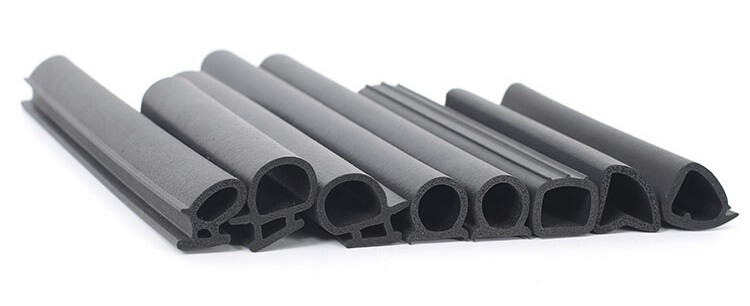Comparative Introduction of Eight Automotive Sealant Strip Materials
Table of Contents

Automotive sealant strips are one of the important components of automobiles, widely used in doors, windows, car bodies, seats, skylights, engine cases, trunk, and other parts. They can be used to produce rubber hinges for installing passenger car luggage compartment doors, and also have other waterproof and sealing functions.
Eight major materials for automotive sealant strips
Vulcanized rubber sealant strip
Generally, it is made of ethylene propylene diene monomer. Excellent comprehensive performance, outstanding ozone resistance, excellent weather resistance, good resistance to high and low temperatures, outstanding chemical resistance, resistance to multiple polar solutes, and low relative density. The disadvantage is that it has a large expansion amount in general mineral oil and lubricating oil, and is generally dark colored products. Operating temperature range: – 60~150 ℃. With its wide range of application and excellent comprehensive performance, it has been recognized by domestic and foreign industry enterprises
Silicone rubber sealant strip
Outstanding high and low temperature resistance, ozone resistance, and weather resistance; Excellent hydrophobicity and appropriate breathability; With unparalleled insulation performance; It can meet the hygiene level required by food hygiene and meet the requirements of various colors. The disadvantage is that the mechanical strength is the worst among rubber materials and is not resistant to oil. Operating temperature range: – 100~300 ℃. It can be used in areas with high temperature, cold, strong ultraviolet radiation, and medium to high-rise buildings.
Neoprene sealant strip (CR)
Compared with other special rubbers, individual properties are poorer, but the overall performance balance is good. It has excellent weather resistance, ozone resistance, heat aging resistance, oil and solvent resistance, good chemical resistance, excellent flame resistance, and good adhesion. Storage stability is poor, hardening occurs during storage, and cold resistance is poor. The relative density is relatively high. Generally black products. Used in environments with requirements for oil resistance, heat resistance, and acid and alkali resistance. Operating temperature range: – 30~120 ℃.
Nitrile rubber sealing strip
Its main characteristics are oil and solvent resistance, but it is not resistant to media such as ketones, esters, and chlorinated hydrocarbons. Its elastic and mechanical properties are excellent. The disadvantage is that it is easy to age and crack during ozone and oxidation, and has poor cold resistance and low temperature resistance.
Thermoplastic elastomer sealant strip
It has good elasticity and excellent wear resistance, good oil resistance, wide adjustable hardness range (Shore A hardness of 65 to 80 degrees), excellent mechanical properties (tensile strength, elongation at break), excellent cold resistance and chemical resistance interwoven corrosion resistance, and high prices for raw materials. It is a recyclable material. Operating temperature range: – 60~80 ℃. Suitable for areas with strong vibrations such as earthquake prone areas, near railways, or factories with high-power cranes, as well as areas with strong ultraviolet radiation.
Thermoplastic vulcanized rubber (TPV) sealant strip
With the flexibility and elasticity of rubber, it can be produced using plastic processing methods without vulcanization, and the waste can be recycled and reused. It is a material with a wide range of properties, good heat and cold resistance, low relative density, oil resistance, solvent resistance similar to neoprene, and poor resistance to compression set and abrasion. Operating temperature range: – 40~150 ℃. Suitable for cold, medium to high-rise buildings.
Plasticized polyvinyl chloride (PVC) sealant strip
The material is cheap and easy to obtain, with corrosion resistance, wear resistance, acid and alkali resistance, and various chemical media, combustion resistance, and high mechanical strength; The disadvantage is that the plasticizer in the coordination system is easy to migrate, hardens and becomes brittle with time, loses elasticity, is not resistant to aging, and has poor weather resistance and low-temperature performance. Generally dark colored products. Suitable for occasions where light is not strong, temperature changes are not significant, and climatic conditions are not harsh.
Surface coating material
It is to coat polyurethane, silicone, polytetrafluoroethylene, and other substances on the surface of the sealing strip to replace the traditional surface flocking process. The coated sealing strip has good wear resistance and smoothness, especially the sealing strip coated with silicone surface coating, which has a small surface friction coefficient and is conducive to the sliding of door and window sashes. Suitable for doors and windows with sliding doors and window sashes. It is a substitute for traditional silicified wool tops.


